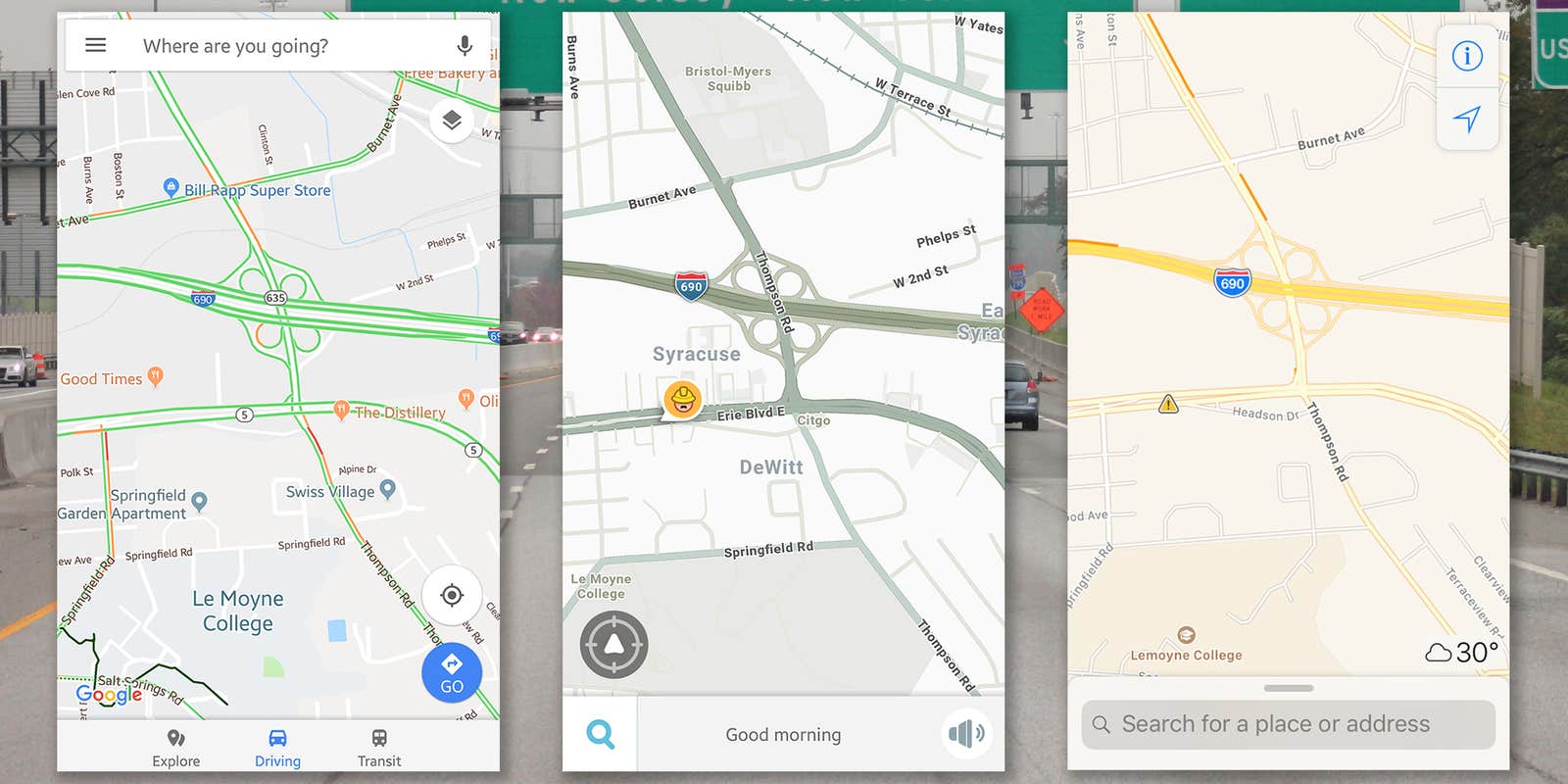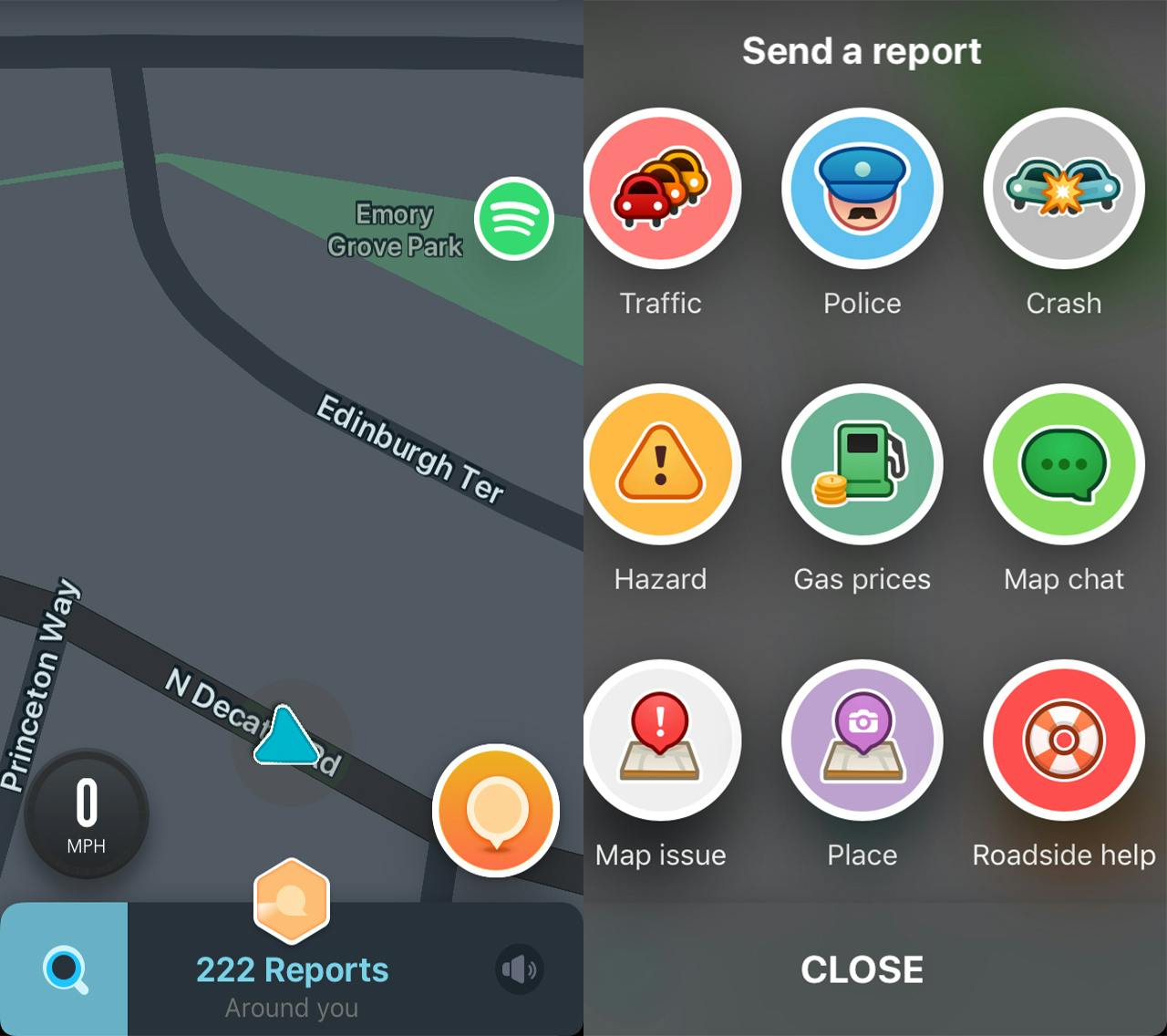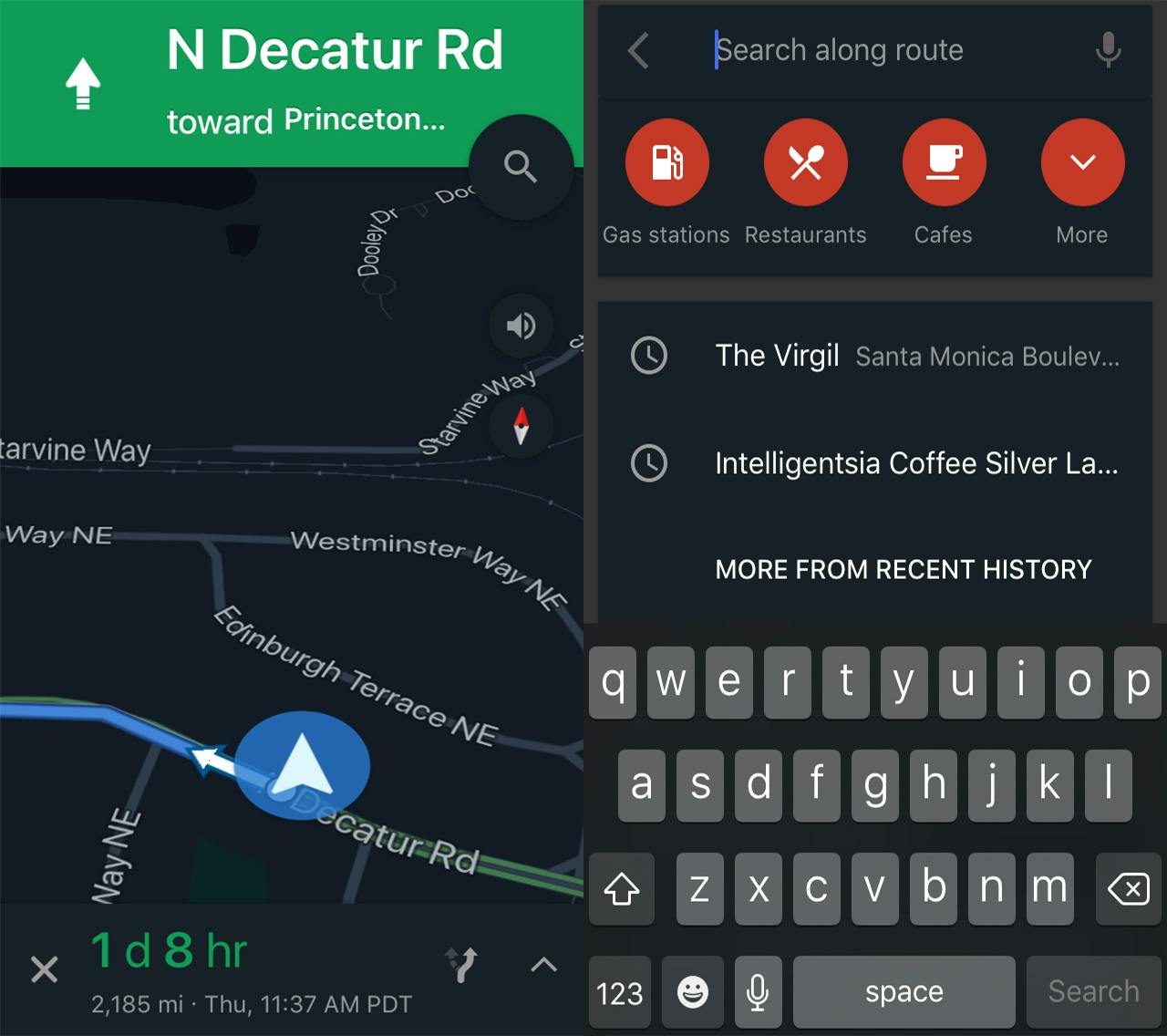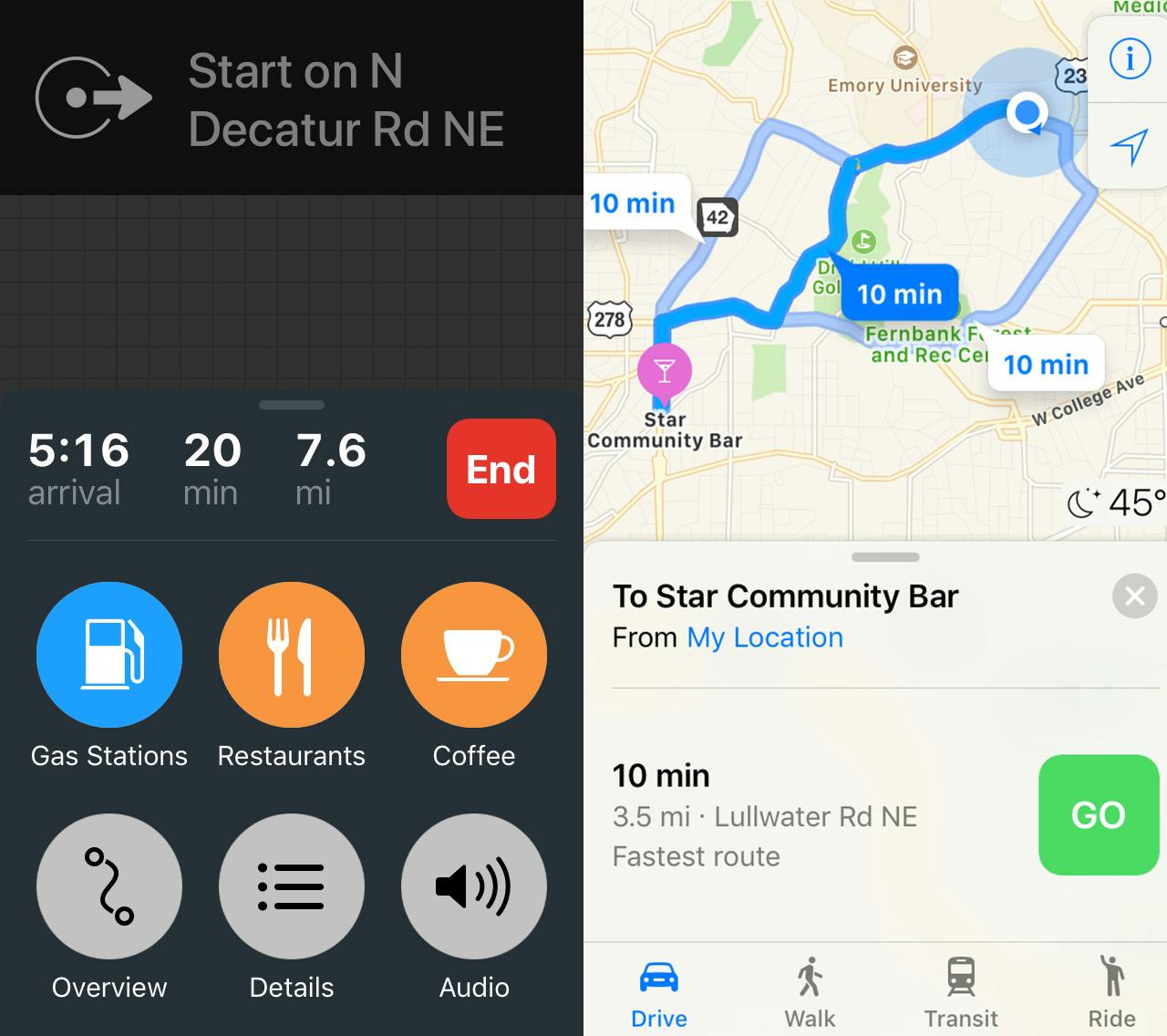There are plenty of navigation apps cluttering the iOS and Android stores, but your decision boils down to three major players: Waze, Google Maps, and Apple Maps. While each one has its perks, in the grand scheme of things, there can be only one ruler of the smartphone navigation world. So we got in the car and tested each one.
Waze vs Google Maps vs Apple Maps: Which one works best?
Waze
Waze is the world’s largest community-based GPS navigation app. By collecting real-time information from its users, Waze can give you the most up-to date-details about your route. Like the other apps on this list, Waze is free, but unlike the others, it includes ads.
Pros: Waze is a fast app that gives you more details about your route than anyone else. Color coding of routes makes preparing for changes in speed easy. User submissions make almost every map a treasure trove of information. You’ll get warnings about upcoming traffic accidents, road closures, police locations, and more from drivers ahead of you. Sometimes the difference between being stuck in traffic for hours and finding a side street is a matter of moments. Waze’s speed of updates gives you that edge. Especially if you’re in a bustling city like Los Angeles or Atlanta with lots of side streets, Waze is a powerful ally.
If you tend to drive too fast, Waze might be able to help. It monitors the current speed limit and lets you know when your car is going too fast. Distracted drivers can also benefit from Waze, as it won’t let users navigate its menus while the car is in motion without identifying the user as a passenger. (While it’s easy enough to bypass while driving, it’s a notable effort.) The app also has a wonderful carpool navigation feature, showing you specifically what traffic is like in the HOV lanes on your route.
Cons: It’s important to point out that while there are times Waze’s real-time updates can be a lifesaver, most of the time you won’t need them. Waze often tends to show users shorter estimated travel times. In my tests, its routes corrected for errors more often. That ultimately lead to travel times that were about the same as the time the other apps. In the instances where a sudden escape is needed, Waze shines, but in most situations, it’s overkill. Waze also doesn’t support multiple stops and has a 1,000-mile distance limit, so you’ll want to pick something else for long trips. Waze’s ads are also frustrating. It may only show you them when your vehicle is stopped, but they cover the entire screen, making it difficult to look ahead while stopped at a light. Waze is also missing some key features. Perhaps most notably, maps can’t be downloaded for offline use.
Google Maps
Google Maps is a user-friendly navigation app that is as simple or powerful as you need it to be. Whether you’re looking for a route for your morning drive, a walking path downtown, or a guide to public transportation, Google Maps has you covered. Google’s street view program has mapped out most of America, showing you what most locations look like in advance. While Maps comes standard on Android phones, iOS users will need to download it in advance.
Pros: Google Maps is incredibly easy to use, the sort of app you can immediately pick up while still discovering new tricks along the way. I’m a massive fan of Google Maps look and screen, which gives you clear directions and a map view all at once. Its navigation background color will even change based on the ambient light in your car. Working on a slim data plan? Google Maps has the best offline functionality of any GPS app, allowing you to download entire cities or neighborhood maps directly to your device.
Google Maps’ pins functions are ideal for sharing your location or saving your favorite places. Secondary routing options let you add a stop to your route along your way. While it’s limited to just two stops, this feature is handy when driving friends home. Google Maps might not have the crowdsourced information of Waze, but it still does an admirable job detecting traffic problems as they arise and rerouting you.
Cons: Google Maps might be powerful, but sometimes it can also be slow to load, particularly during busy traffic times. Downloading maps for offline use is a great feature, but make sure you turn off automatic updates and only download them when you’re connected to Wi-Fi since each map can be hundreds of MB in size. Google Maps also doesn’t give you a heads up about anything but traffic. If it’s important for your navigation app to warn you about a speed trap up ahead, Google Maps will let you down.
Apple Maps
If you were turned off by Apple Maps at launch, there’s never been a better time to give the app a second look. Its big display style might not be for everyone, but those who take to it will appreciate how simple it makes reading directions.
Pros: Apple Maps has a clear navigation screen that’s free of distractions. While Google Maps and Waze both offer options for helping you find gas and restaurants along your way, Apple Maps’ quick pull-up menu is the easiest to find. Like Google Maps, Apple Maps features an automatic nighttime mode that will adjust the screen to be easier on your eyes depending on when you’re using it. Apple Maps also shows you exactly what kind of turns are coming up. If you’re headed into a roundabout, it will show you using shapes exactly where to turn. It’s a little touch, but one that visual navigators will appreciate. The app also integrates with the Apple Watch, offering haptic feedback to alert you to turns. I also found that Apple Maps tended to be the most accurate when it came to guessing how long trips would be from your starting point. It’s also worth noting that in my tests on iOS, Apple Maps used dramatically less battery life than either Waze or Google Maps.
Cons: Apple Maps shows you slowdowns in traffic. However, the way it focuses so much on your current location makes quickly glancing ahead at the app and seeing future problems difficult. Like Google Maps, it doesn’t warn you about speed traps the way Waze does. Apple Maps oddly doesn’t allow you to download maps for offline use, giving Google Maps a clear advantage in features.
Waze vs Google Maps vs Apple Maps: The winner
Google Maps
When you need to get home, accept no substitutes. Of the three major apps, Google Maps has been around the longest, at one point being the stock navigation app for Apple. Its deep features will appease even the most jaded of tech fans while still being easy to pick up and use. Offline maps, remarkable route planning, multi-route planning, night mode, and every other little feature add to up an app with something for everyone. While it would be great if Google would let people report speed traps, it’s a small sacrifice to make for the best navigation in the business.
Need more proof? Artur Grabowski documented 120 trips using Google Maps, Waze, and Apple Maps. He found that while Waze might actually estimate a shorter trip, Google Maps actually got him to his destinations faster.
Runner-Up: Waze
Waze might be too intense for everyday use, but it’s worth saving space for on your phone. Users who value a heads up about traffic cops will swear by it forever, but its ability to find the right backroad when the route home is blocked simply can’t be praised enough. It would be great if Waze operated a little faster and if its crowdsourced information was a little more reliable, but it still manages to beat out Apple Maps, a fine service that doesn’t offer enough killer features to truly stand out. It’s worth having a backup navigation app on your phone. Make yours Waze.





